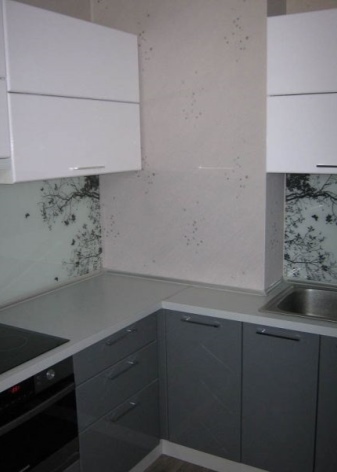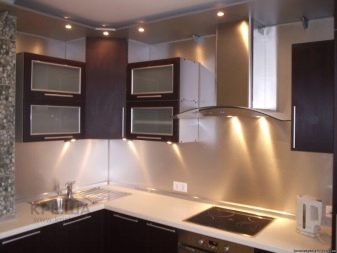Layout and design of a kitchen with a ventilation box in the corner

The kitchen is an important space in the house, which is why the organization of the work space and recreation areas in it require a special approach from home owners. However, some features of the device of this room require the introduction of non-standard solutions in terms of layout, in particular, this applies to the ventilation duct, which is present in most kitchens.


Purpose and types of ventilation ducts
A box in a room, especially one located in the kitchen in the corner, in some cases can cause serious difficulties in the arrangement and design of the room. but this element is an important component in the overall project of a residential building, so its demolition is unacceptable. That is why many designers and planners try to usefully use such protrusions in the wall, thanks to which the box can be successfully hidden or beaten in such a way that it becomes a useful and functional part of the entire interior. The main task of the ventilation shaft is to ensure good air exchange, therefore, such boxes can most often be seen in rooms in which, based on their functionality, for the most part, high air humidity remains.


Thanks to such a system, the concentration of moisture in the bathrooms and in the kitchen is practically excluded, in addition, the ventilation mine can partially remove extraneous odors and dust.
With a competent layout, even in small kitchens, the box will not be conspicuous, and some design nuances can completely hide it from view.
Based on the design features of a residential building, ventilation protrusions can be of the following dimensions:
- up to 600 mm deep;
- more than 600 mm.


As for the shape, most often the risers are as follows:
- rectangular;
- with rounded edges;
- complex geometric shape.



Important! As a rule, it is the rectangular options that are easiest to hide in the overall design of the space.
And also the boxes differ according to the location. In most kitchens, the mine can be found in the right corner of the room or in the center, but in some buildings it is located near the entrance to the room. Boxes are classified according to the type of material used for their manufacture. Today you can find several options.
- Moisture wicking element, for the creation of which galvanized metal was used. Such designs are distinguished by their strength and durability. In addition, the raw materials are not afraid of corrosion. As a rule, the box has a minimum mass, and is rectangular or round in shape.
- Asbestos cement boxes... Such components of the construction of a residential building are used very rarely today. This is due to the large mass of the plates, as well as poor tightness.
- Reinforced concrete ventilation ducts... Usually they are additionally equipped with several openings, thanks to which natural air exchange takes place.
- PVC boxes... Such elements are in great demand, as they stand out for their resistance to various environmental factors, and the elements are easy to assemble. Ventilation of any shape and color can be made of PVC, in addition, the material has a low degree of combustion.



Important! To change the configuration of the ducts on your own, a special permit is required, since there is a serious risk of damage to the entire ventilation system in the building.
Features of the layout
The primary task in the implementation of the kitchen layout plan is to determine the area of the room, as well as the size, location and shape of the ventilation duct. Corner elements that are located next to other communications in the room will be several times easier to fit into the general idea of \ u200b \ u200bthe arrangement. Those structures that are installed in the middle of the working wall will require more daring design solutions. A distinctive feature of the selection of the appropriate layout for such kitchens is the competent choice of the type of finishing materials that will be used in the work. It is important that they are compatible with the type of raw material from which the box itself was made.


In addition, there are a number of restrictions on the use of certain materials based on safety precautions in a room where there are sources of fire. So, it is forbidden to use wallpaper or PVC panels during the finishing process for bases that are in close proximity to the gas stove. This is due to the increased degree of flammability of these types of products. If the ventilation structure is located near the kitchen sink, then you should not finish it with decorative plaster, which will quickly become unusable from excess moisture.


How to close the pipes?
Today, interior designers and designers use a number of effective tricks that can be used to hide a ventilation riser in the kitchen.
Corner structures can be hidden using one of the following options:
- arrange the box in such a way that it acts as a decorative component of the room;
- disguise the ventilation shaft by hiding it in the kitchen furniture set;
- designate the structure as a functional component of the working or dining area.


Choosing a suitable project option for yourself, it is important that the created element fits into the overall style as harmoniously as possible. As a decorative element, the structure can act as a connecting element in the interior or as a bright accent of the whole idea of a design idea.
In this case, several ways of decorating the box can be adopted.
- The ventilation shaft can be designed in the form of a column in the kitchen, and a similar element can be appropriate in many style solutions. An alternative to stone or brickwork can be modern building materials, such as gypsum plaster, with which you can make stucco on the structure.
- Arrangement of a ventilation element in the form of a false fireplace. Quite a simple and budgetary option for creating a beautiful decorative design in the kitchen. As a rule, for the assembly, you will need sheets of drywall, and in this case, candles or an electric element can act as a fire, and similar structures can be equipped with a monitor with an image of hot coals or photo wallpaper.
- You can also hide the riser with siding panels, but on condition that the box is removed from the slab.
- An original and simple solution for masking the ventilation element can be the use of moisture-resistant wallpaper. The modern assortment allows you to pick up the whole composition, highlighting the detail in the interior. In addition to textured monochromatic or multi-colored materials, you can decorate the element using photo printing on the material.
- A more painstaking, but beautiful solution will be a two-level finish, which can combine elements of mosaics and other finishing materials.



If it is not possible to make the box an element of decor in the kitchen due to its location or shape, it is worth considering the following ideas on how to correctly hide it behind the main furniture in the room:
- the air vent shaft can become part of the working area if you lengthen the tabletop in the area of the box, and at the top you can place small functional shelves or cabinets; you can store useful kitchen tools or various figurines and decor items in them;
- the box can be hidden in the closet itself if you equip the kitchen with custom-made furniture;
- the ventilation protrusion can be used as an extension of the apron in the kitchen work area, finishing it in the color of the main furniture or wall surface.



As a creative use case for a design, you can resort to design in the following ideas:
- decorate the element with mirrored panels that will help visually expand the space;
- the structure can become a whiteboard for writing, placing magnets and other beautiful little things in the room;
- the box will be a great place for arranging an area with photographs.


If the owners of the premises prefer practical solutions, then the ventilation shaft can act as a surface for placing a monitor or TV.
In addition to the shelves, a rod or hooks can be attached to the base of the element so that the structure becomes a place for storing various kitchen utensils. A modern and fashionable solution is the arrangement of a folding bar counter, which will add variety to the interior of any kitchen.


Successful examples in the interior
- To highlight this functional element of the building, turning the classic kitchen interior into a non-standard, but rather practical option, it is worth positioning the headset and the countertop at an angle. The ventilation box in this layout will turn out to be a corner joint with this arrangement of furniture. The structure will act as a base for attaching wall cabinets at the top. In this case, the lower part of the box will become a continuation of the working area, which can also be added functionality by using it to store kitchen utensils.

- In order for the structure to become a decoration and highlight of the entire room, the role of a decorative column with imitation of stucco or semi-antique brickwork can be distinguished in the ventilation shaft. In addition to the decorative function, such a solution will also be useful if you decorate the column with a clock or other useful element in the house.

- Another good design option would be to use a box for placing a TV. A similar detail in the kitchen will add coziness. In addition, eating or preparing it can be combined with watching your favorite movie or TV show. And the area in the room itself will not burden the space, since it will acquire a certain functionality.

For information on how to successfully remove the ventilation box, see the next video.













The comment was sent successfully.